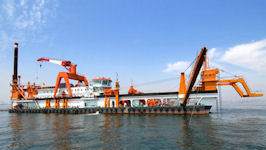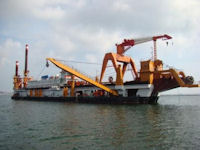Tianqi / Tianyi / Tian Qi Hao
In 2009, China launched sister ships, Tianqi and Tianlin, Asia’s largest stationary cutter-suction dredgers (CSDs) at the time. Apart from "Tianjing" Dredger, the "Tianqi" [Sky] dredger, which is operating in Yongxing Island, a major island in Xisha Islands, is the largest non-self-propelled cutter suction dredger in Asia. It is entirely developed by Marine Design & Research Institute, Shanghai Jiao Tong University. Tian Lin Hao, sister dredger of Tian Qi Hao, with a nominal production capacity of 4500m3/h, is Asia's largest stationary cutter suction dredger and can dredge clay, dense sand, gravel soil and hard rock.
Although systems for describing dredgers vary, in general three broad classifications are recognised based on the means of excavation and operation. These are known as mechanical dredgers, hydraulic dredgers and hydrodynamic dredgers. Hydraulic dredgers include all dredging equipment which makes use of centrifugal pumps for at least part of the transport process of moving the dredged materials, either by raising material out of the water or horizontally transporting material to another site.
Cutter suction dredgers (CSDs) are classified as hydraulic dredgers and are the most common vessels in the hydraulic/mechanical category. CSDs have the ability to dredge nearly all kinds of soils (sand, clay, rock) and are used where the ground is too hard for trailing suction hopper dredgers.
CSDs are equipped with a rotating cutter head, which is able to cut hard soil or rock into fragments. The cutter head is a rotating mechanical device, mounted in front of the suction head and rotating along the axis of the suction pipe. The cut soil is then sucked in by dredge pumps. CSDs cut the soil according to a pre-set profile. The dredged material is then pumped ashore using pumps and a floating pipeline. When the dredged material is being used for land reclamation, the distance between the dredging and disposal areas is usually shorter than the distances covered by trailing suction hopper dredgers.
The suction tube and cutter head are attached to the so-called ladder, which is positioned at the fore of the vessel. To begin with, this ladder is lowered under water, then the dredge pump(s) are started and the cutter head set in motion. The ladder is then moved down until it touches the seabed, or until it reaches the maximum depth. If the required dredging depth has not been reached at the end of a swing, the ladder is set more deeply and the ship will move in the opposite direction.
CSDs are always stationary when they are working – even if they are self-propelled. To lock the vessel into a stationary position, a CSD generally has two spud poles. One spud pole (the auxiliary spud) passes straight through the vessel, while the other, the working spud, is mounted on a movable spud carriage, which can be moved lengthwise along the vessel. Although the vessel is stationary, moving the spud carriage causes the dredger to move. This is known as ‘stepping’.
The ship is equipped with international advanced ABB electrical equipment and inverter control system, cutter suction dredger automatic control system, steel pile trolley device system, shallow water pile inversion system, three cable positioning system, strong anti-wave and wave power, cutter power 2000 Kilowatts, the bridge weighs 600 tons, are the most Asian ships of the same type. The ship can dig clay, dense sand, gravel soil and strong weathered rock, mainly for large-scale dredging projects at home and abroad.
| Gross tonnage | 4950 tons. |
| total length | 120 meter |
| width | 20.3 meters |
| Depth | 6.6 meters |
| maximum depth of digging | 30 meters |
| Total installed power | 17,280 kilowatts |
| maximum production capacity | 4000 cubic meters/ Hour, |
| row distance | 6300 meters |
|
NEWSLETTER
|
| Join the GlobalSecurity.org mailing list |
|
|
|






